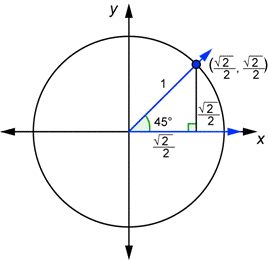This WPP13-14 was made in collaboration with Vanessa Ceja. Please visit the other awesome posts on her blog by going here.
Create your own Playlist on LessonPaths!
 We use the law of sines because it helps us evaluate the side lengths or angles for triangles, in this unit mainly oblique triangles. It is a simple process of evaluating these missing sides by making to proportions based on what we know and what we need. The proportions you will need will be based on the law of sines formula given to the right.
We use the law of sines because it helps us evaluate the side lengths or angles for triangles, in this unit mainly oblique triangles. It is a simple process of evaluating these missing sides by making to proportions based on what we know and what we need. The proportions you will need will be based on the law of sines formula given to the right. Since we know that Sine is opposite/hypotenuse, we can use both angles A and C to make two trig functions. The two trig functions that came from this triangle are shown on the second picture. (The very top one)
Since we know that Sine is opposite/hypotenuse, we can use both angles A and C to make two trig functions. The two trig functions that came from this triangle are shown on the second picture. (The very top one)

 1. When deriving the equilateral triangle, you must cut the triangle in half so that one side can remain as 60 degrees, one can be 90 degrees, and the other one can be 30 degrees since it is half of the triangle. We know that all sides of the equilateral are equal to 1. Since it is cut in half, the bottom side is equal to 1/2. (as shown on the bottom left) The hypotenuse is equal to 1, so we know what a & c are equal to. So to find the value of the height, we must use the pythagorean theorem. My work is shown on the bottom right which gives us the value of the height which is rad 3/2. We know that
1. When deriving the equilateral triangle, you must cut the triangle in half so that one side can remain as 60 degrees, one can be 90 degrees, and the other one can be 30 degrees since it is half of the triangle. We know that all sides of the equilateral are equal to 1. Since it is cut in half, the bottom side is equal to 1/2. (as shown on the bottom left) The hypotenuse is equal to 1, so we know what a & c are equal to. So to find the value of the height, we must use the pythagorean theorem. My work is shown on the bottom right which gives us the value of the height which is rad 3/2. We know that 
 a 30-60-90 triangle has side values of n, n rad 3, and 2n. The variable "n" is a constant. In this case, our n is 1/2 which gives us these answers but the value of n can vary depending on the problem they give you. But, they all end up falling under the same guidelines.
a 30-60-90 triangle has side values of n, n rad 3, and 2n. The variable "n" is a constant. In this case, our n is 1/2 which gives us these answers but the value of n can vary depending on the problem they give you. But, they all end up falling under the same guidelines. 
 A 45* triangle involves having 2 side lengths that are the same length. These two sides can be 1 or just the variable x. The hypotenuse for the special right triangle is radical 2. However, for a unit circle, we want the hypotenuse to equal 1. Therefore, we must divide the side lengths by radical 2 on every single side. Once we work that out, we are able to get the values of both x and y which are radical 2 over 2. To put these into our coordinate plane, we know what the values of x and y are so we just make or coordinate (radical 2 over 2, radical 2 over 2) The coterminal angles for a 45* angle are 135*, 225*, and 315*.
A 45* triangle involves having 2 side lengths that are the same length. These two sides can be 1 or just the variable x. The hypotenuse for the special right triangle is radical 2. However, for a unit circle, we want the hypotenuse to equal 1. Therefore, we must divide the side lengths by radical 2 on every single side. Once we work that out, we are able to get the values of both x and y which are radical 2 over 2. To put these into our coordinate plane, we know what the values of x and y are so we just make or coordinate (radical 2 over 2, radical 2 over 2) The coterminal angles for a 45* angle are 135*, 225*, and 315*.